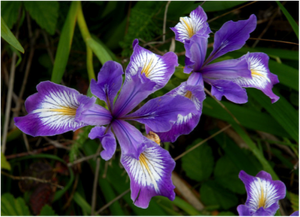 Common name: Oregon iris, tough-leaf iris, flag iris
Common name: Oregon iris, tough-leaf iris, flag iris
Scientific name: Iris tenax
Plant family: Iridaceae
Description: Oregon iris is a showy perennial herb found in clumped distributions growing to about 40 cm tall.[1] This flower arises with many basal leaves from a fibrous-covered rhizome. The leaves are grass-like with parallel veins generally 4 and they are 1-5 cm. long. As all members in the Iridaceae the flower has a bilateral symmetry and 6-petal like segments in two series all fused at the base. In the Oregon iris, the sepal is purple, but often lavender with yellow at the center. The whole sepal is conspicuously veined with darker purple, each of them reaches 7.5 cm in length and is broad at summit. The petals are narrower than the sepals, erect, and uniformly purple or lavender. [2]
Habitat and Range: Oregon iris is found in open areas such as grassy meadows, fields, pastures, roadsides, logged areas. It is also found in open woodlands either deciduous or coniferous.1 It thrives in low and medium elevations. This herb does well in full sun exposure or partial shade but can succeed in dry shade and can be drought tolerant once it is established.[3]This plant can be found in Western North America from Washington to Oregon and California[4]
Historical and Contemporary Uses: The main use of the Oregon iris is for fiber. A fiber from the leaves is used in weaving and making ropes.[3, 4] The Nehalem- Tillamook Indians made strings, cords, and net fibers from the iris by pulling the strong central fibers from the center of the leaf and then winding these strings together to make long threads of fiber.[5] This fiber is buoyant, strong and durable and would be wound together to produce fish nets or serve as the lines that attached the fish harpoon points to the harpoon shaft.[5] David Douglas, the 19th century botanist said “…in point of strength it will hold the strongest bullock and is not thicker than the little finger” [1]
A tincture of the whole plant, or the bulbous stems, is given in the treatment of bilious vomiting and is recommended for treating depression. Today it is an ingredient in modern pharmaceuticals to prevent vomiting and sleeplessness. The entire plant, especially the root is thought to be poisonous if ingested [3], however there is some documentation that expresses the use of the root as a beauty treatment. The boiled root is said to clear the complexion as well as treats bruises and sores.

